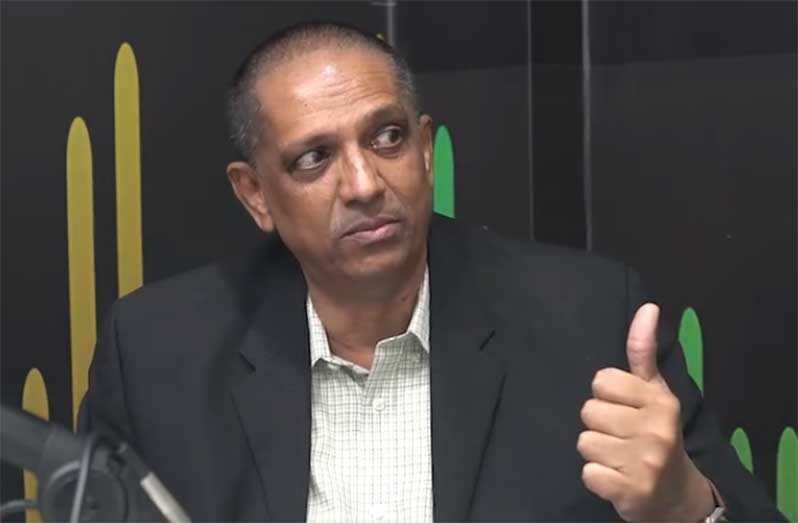— says initiative will position Guyana as regional leader in agro-processing
By Feona Morrison
THE ambitious Gas-to-Energy project in Guyana is set to significantly enhance the country’s competitiveness in the global export market, according to Ramsay Ali, Chief Executive Officer (CEO) of Sterling Products Limited and President of the Guyana Manufacturing and Services Association (GMSA) Limited.
It is anticipated that the project, which would supply associated gas from offshore ExxonMobil Guyana-operated projects (Liza Phase 1 and Liza Phase 2), will increase efficiency, generate new economic growth prospects, and reduce energy costs by up to 50 per cent.
Upon being commissioned, the project’s pipeline would transport a maximum of 50 million standard cubic feet per day of natural gas to both a power plant and Natural Gas Liquids (NGL) facilities.
GAME-CHANGER
Speaking on a recent episode of the Energy Perspectives Podcast, Ali highlighted the transformative potential of the Gas-to-Energy project.
“You have a game-changer coming on board,” he said.
On the other hand, he shared his opinions about why Guyana lacks competitiveness in the global market. “One of the reasons why we are not so competitive in the export market is [because] of the cost of production. And one of the reasons why the cost of production is so high is because of the cost of energy. That has been the story of our lives.”
Ali used the example of Trinidad and Tobago’s roughly one-third lower energy cost to argue that the country has always had an industrial “edge” over Guyana. Supermarkets here, he said, are overflowing with goods made in the Twin-Island Republic.
He added that in order to have energy that is more affordable and reliable, many of Guyana’s largest manufacturers—such as Edward B. Beharry and Company, Banks DIH, NAMILCO, and Sterling Products Limited—generate their own electricity.
Because of the sizable diaspora, the CEO said that some of these businesses have been able to sell their goods in the USA and the Caribbean, but the margins are extremely slim.
“You just don’t have the difference between your cost of production and sales. We do it mostly for tax purposes and because we want to expand our share of business. But really and truly, you don’t make a significant amount of profits in exports simply because of the cost of production,” he reasoned.
However, he stated that Guyana can greatly cut energy costs, offer reliable energy, and significantly lower the cost of manufacturing for companies by utilising its natural gas resources.
Additionally, he stated that this will draw on foreign investment and increase the competitiveness of products in the global market.
Ali emphasised: “If you can have that kind of reduction in your cost of energy, these companies’ export ability will significantly be raised.”
REGIONAL LEADER IN AGRO-PROCESSING
Guyana is reclaiming its title of being the “Bread Basket of the Caribbean” and this is crucial to the realisation of ‘Vision 25‘, which aims to reduce the region’s food import bill by 25 per cent by the year 2025.
Shifting his attention to smaller businesses, particularly agro-processors, he mentioned that many of them have improved their operations, most of which began in their own kitchens. The GMSA has registered approximately 120 agro-processors.
The CEO made a significant declaration regarding Guyana’s potential to emerge as a prominent agro-processing leader in the region. This is attributed to the Gas-to-Energy project and substantial government investments in climate-smart agriculture, particularly shade houses.

He alluded to the shade house projects which are producing on a commercial scale.
Based on his assertion, these companies have made substantial investments in high-priced equipment to ensure quality control; however, they are grappling with the issue of escalating energy costs. Ali expressed great enthusiasm for the potential positive impact of the Gas-to-Energy project on small enterprises.
“If they can see a 20 per cent reduction in their cost or a 30 per cent reduction in their cost because of energy that is going to be game-changer for them.”
“If you see what is coming out of those shade houses. It’s amazing. We can do broccoli. We can do onions. we can do bell peppers. All the stuff that we are importing that are going on those FPSOs [Floating Production Storage and Offloading vessels], can be done right here. We have to process them,” said Ali, as he emphasised the magnitude of the shade house project.
The CEO of Sterling Products Limited stated that production and consumption in Guyana have seen a notable increase, driven by the country’s growing industrial activities and expanding consumer market. Ali reasoned that the nation’s manufacturing sector is showing favourable tendencies as a result of this boom, which signals increased economic activity and a rising demand for locally made goods.
He made this observation regarding the enormous protentional of Guyana’s manufacturing sector: “If we can maximise and market that word organic, it is going to be amazing. We are doing that at the GMSA. The Europeans… the Americans gravitate towards that idea of no chemicals. So, the market is expanding, the technology is there, the energy cost is going to go down. Then, it’s going to be a win, win for everybody.”
BACKGROUND ON GAS-TO-ENERGY PROJECT
Together with CNOOC Petroleum Guyana Limited and Hess Guyana Exploration, its co-venture partners on the Stabroek Block, ExxonMobil Guyana is working with the Government of Guyana to advance the Gas-to-Energy Project.
The Gas-to-Energy Project will see a 200km 12-inch diameter pipeline channelling natural gas from the Liza Phase One and Liza Phase Two FPSOs to a power plant NGL facility that will be built in Wales, West Bank Demerara (WBD).
That pipeline will be landing on the West Coast Demerara (WCD) shore and continue approximately 25 kilometres to the NGL and power plant facilities.
It has an estimated total cost of US$1.8 billion and is cost recoverable. The Gas-to-Energy Project is expected to be up and running by the first half of 2025 and has a 25-year lifespan.



.jpg)








